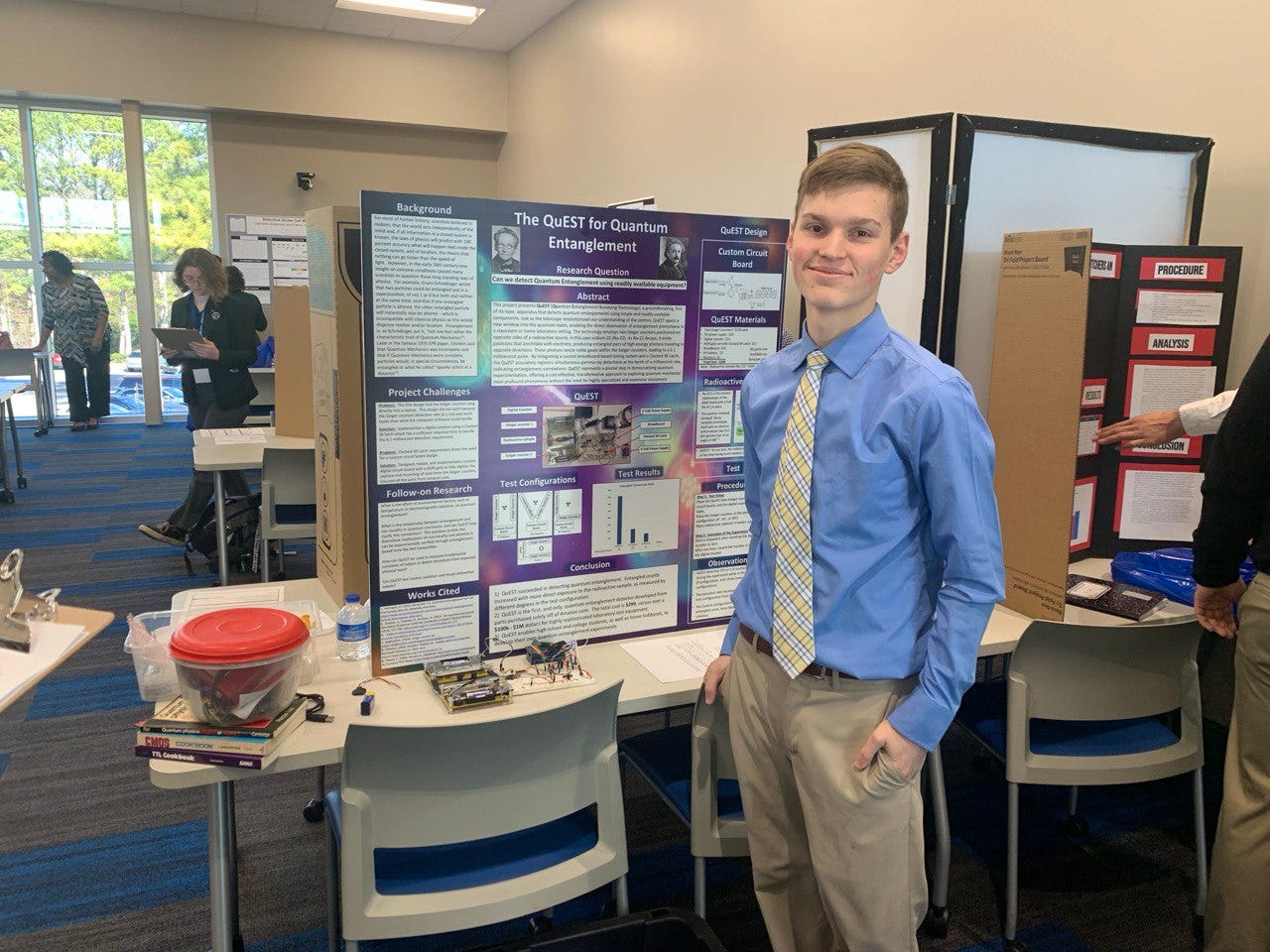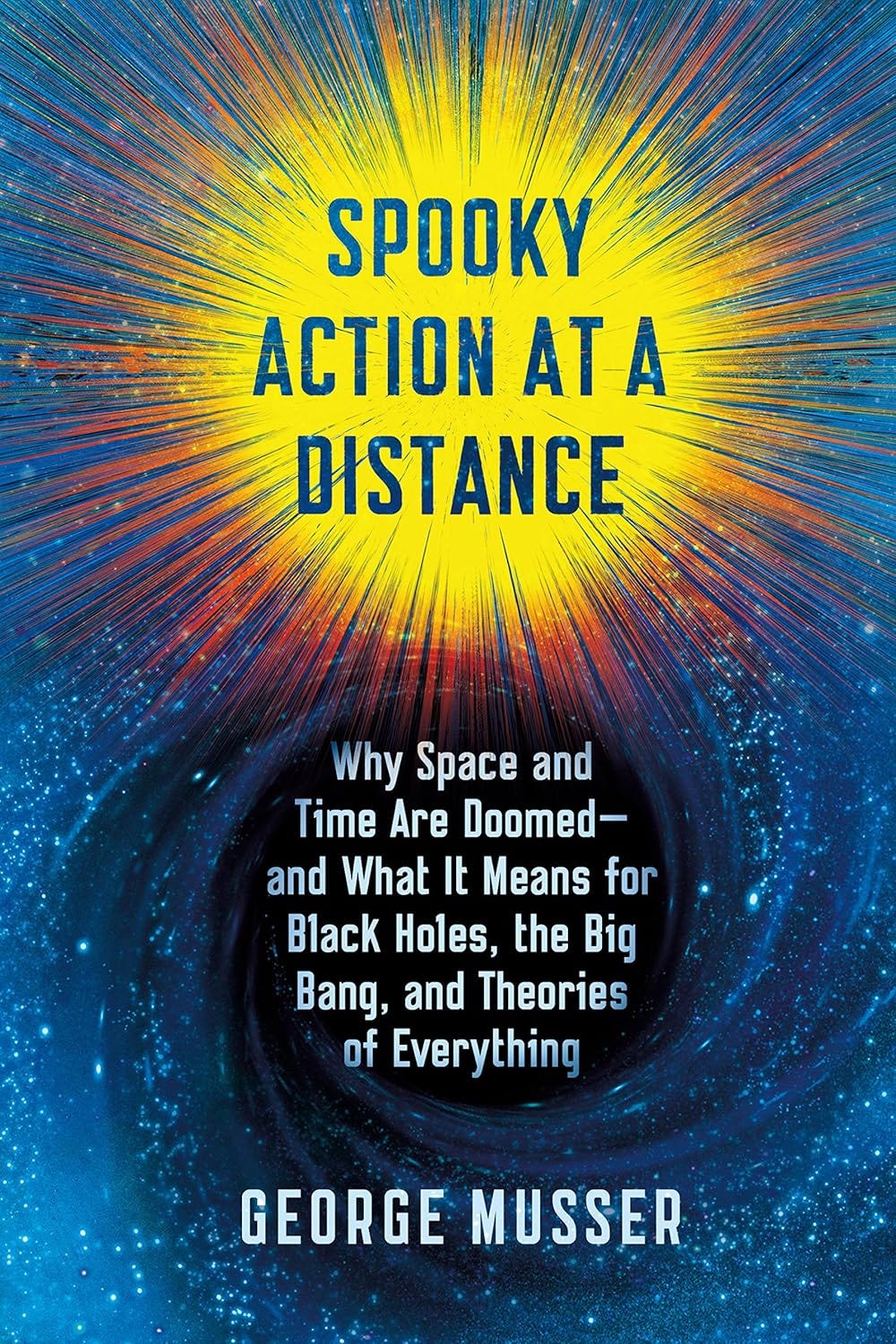The Society for Post-Quantum Research
Congratulates Corbin Hawkes for his Quantum Entanglement Science Fair Victory
The Society for Post-Quantum Research, LLC congratulates Corbin Hawkes for his first-place finish in the North Alabama Regional Science & Engineering Fair (NARSEF). Hawkes’ winning project was “Quantum Entanglement Surveying Technology (QuEST),” a system for generating and detecting quantum entanglement using off-the-shelf components. Hawkes is a Quantum Entanglement Research Assistant and Founding Member of The Society for Post-Quantum Research, LLC. He performed his work under the mentorship of SPQR founder and Principal Scientist, Dr. Hans G. Schantz.
Competing against students from public and private high schools across 13 north-Alabama counties, Corbin won first place in the Physics Division, earning him a slot to compete at the State science fair (ASEF) in April. Additionally, Corbin won three “Best Overall Paper” awards from three Science Fair sponsors, the US Space and Rocket Center, the Von Braun Astronomical Society, and the Huntsville Electro-Optical Society, as well as a second place overall award from the Robert Herndon Memorial. These special awards came with $1,500 in cash and prizes.
QuEST: From Matter-Antimatter Annihilation to Entanglement
Hawkes’ QuEST uses matter-antimatter annihilation to create entangled pairs of high-energy (511 keV) gamma rays. The physicist, John A. Wheeler (1911–2008), hypothesized in 1946 that these annihilation gamma rays should be orthogonally polarized [J. A. Wheeler, “Polyelectrons,” Ann. New York Acad. Sci. 48, 219-238 (1946); see p. 235]. Their entangled behavior was experimentally verified by Wu and Shaknov in 1950 [C.S. Wu & I. Shaknov, “The Angular Correlation of Scattered Annihilation Radiation,” Phys Rev 77 (1), Jan 1, 1950, p. 136].
How It Works
Hawkes’ system incorporates a pair of open source Geiger counters designed by Jeff Keyzer (aka MightyOhm), purchased from Amazon, and assembled from kits. Hawkes designed and implemented a logic circuit for comparing the outputs of the two Geiger counters and detecting the simultaneous incidence of gamma rays. By demonstrating that the coincidences occur at a statistically significant rate, Hawkes confirmed that the detections correspond to entangled gamma ray pairs.
Hawkes employs a US Nuclear Regulatory Committee and State License exempt 1 microcurie sodium-22 source with a half-life of 2.6 years to generate the antimatter his experiment requires. In the beta-positive decay of this radioactive sodium-22 isotope, a proton decays into a neutron, a neutrino, and a positron or anti-electrons (e+). The sodium-22 becomes stable neon-22. When the positrons emitted in this decay encounter regular electrons, they annihilate, and their mass-energy is converted into an entangled pair of gamma rays.
Learn More
Hawkes’ approach was inspired by George Musser’s 2013 Scientific American article, “How to Build Your Own Quantum Entanglement Experiment.” Sadly, none of the hardware Musser used in his article is currently available, requiring Hawke to design his own implementation from scratch. Musser’s book, Spooky Action at a Distance: The Phenomenon That Reimagines Space and Time--and What It Means for Black Holes, the Big Bang, and Theories of Everything is an excellent introduction to quantum entanglement, and his Spooky Action Book website is a superb resource as well.
About The Society for Post-Quantum Research
The Society for Post-Quantum Research, LLC is dedicated to advancing the science and technology of the coming post-quantum era.
Our mission is to foster cutting-edge research, collaboration, and education in post-quantum science and technology:
Research: We apply innovative ideas from electromagnetic theory to untangle difficult problems in quantum mechanics.
Collaboration: We work with talented scholars and technologists on projects ranging from robotics to quantum entanglement. We focus on engaging with young and early-stage researchers, like Corbin Hawkes.
Education: The Fields & Energy Substack is where we serialize Fields & Energy: How Electromagnetism and Quantum Mechanics Work and Where Physics Went Wrong, by SPQR founder and Principal Scientist, Dr. Hans G. Schantz.
Continue to follow the Fields & Energy Substack for more updates on SPQR activities. All updates are free, but paid subscribers receive a complimentary membership to the SPQR.
Enjoyed the post and project, but maybe not quite enough to spring for a paid subscription?
Then click on the button below to buy us a coffee. Thanks!
Follow Online:
You may follow SPQR founder and Principal Scientist, Dr. Hans G. Schantz, online in other places as well:
Telegram: 𝔸𝕖𝕥𝕙𝕖𝕣𝕔𝕫𝕒𝕣'𝕤 𝔸𝕖𝕥𝕙𝕖𝕣𝕤𝕥𝕣𝕖𝕒𝕞
Gab: @aetherczar
Twitter: @aetherczar
Amazon: Hans G. Schantz











SPQR? I see what you are doing there. And I love it!
I encourage students interested in doing interesting physics research to consider reproducing the recent experiments proving EM fields propagate instantaneously in the nearfield and reduce to about speed c in the farfield. In one experiment just published in the peer reviewed EM journal IRECAP, an EM pulse was observed to propagate 1.5 m to a detector in the nearfield, with no observed propagation delay. This shows that the front speed, or the speed of information is instantaneous in the nearfield, which proves Relativity is wrong, since it proves the speed of light is not only not constant, but also instantaneous in the nearfield which invalidates the Relativity of Simultineity, since instantaneous signals will appear the same for all inertial observers. This can be seen by inserting c=infinity into the Laplace transform, yielding the Galilean transform, where space and time are absolute. The experiment is basically Hertz's famous radio wave experiment, but uses a modern 50MHz digital oscilloscope to measure the propagation delay. A simple inexpensive hand cranked Wimshurst machine can be used to generate the ~30kV EM pulse. For more information see the links below:
*YouTube presentation of above arguments:
https://www.youtube.com/watch?v=sePdJ7vSQvQ&t=0s
*More extensive paper for the above arguments: William D. Walker and Dag Stranneby, A New Interpretation of Relativity, 2023:
http://vixra.org/abs/2309.0145
*Electromagnetic pulse experiment paper:
https://www.techrxiv.org/doi/full/10.36227/techrxiv.170862178.82175798/v1
Dr. William Walker - PhD in physics from ETH Zurich, 1997